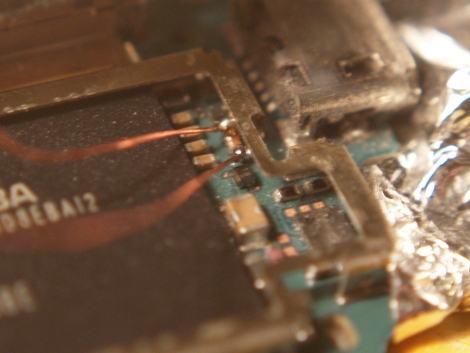
[Script] is pretty lucky. One of the engineers who designed his cellphone included over-voltage protection in the circuit. Of course you probably wouldn’t know about this if there wasn’t a service schematic available. But a bit of searching around let him resurrect the fried USB segment of his Nokia N900.
Now [Script] has been experimenting with portable solar power like the system featured at 25C3 a few years back. Unfortunately he made an error which routed 12V into the USB connector’s 5V rail. After this unfortunate mistake the phone would not longer connect via USB, or charge the battery. Luickly the N900 is a favorite with the hacker community (you can see all kinds of N900 related projects here at Hackaday) and [Script] found his way to their N900 Schematic page. Digging into page four he found part F5300 which is labeled 2.0A. He removed the PCB and shielding, and tested the part with a multimeter to confirm it was blown. A quick wire bridge got the phone charging again, but [Script] plans to position a new fuse as soon as he can source the part.
Who says these devices aren’t user serviceable? If we could just get our hands on more service schematics perhaps our gear would last longer.















Fuses labeled 2.0A are for overvoltage protection?
YES.
Here’s my trolling math to prove it;
E*I=P (watts)
E/I=Ohms
E/Ohms=I
3.7v charger with a DC clamp-on ammeter shows phone drawing 700mA.
This gives us virtual E/I=Ohms, or
3.7v/0.7I = 5.28 Ohms.
12v on a 5.28 Ohm load = 2.2727 amps (I)
Sure, other things in the charging circuit will affect this…but this is why you dont share neutrals between branch circuits in a home. Lose a neutral, and you’ll connect phases through plugged-in devices.
I need to start hacking phones. Looks like fun.
I’m afraid your math does not help in this case as the current does not stem from the internal circuits, but from the avalanche breakdown of the Zener diode. Also modeling such a complex USB device as a linear element is probably not the best idea to reason about voltages and currents.
Interesting, the USB spec states that devices accepting USB power need to be 20v tolerant IIRC. It’s definitely higher than 12. I wonder if the Nokia was in spec when it was designed.
What bullcrap. Anything designed to accept USB power is supposed to be able to handle at least 20v, IIRC. Not necessarily utilize such high voltages, but at least shut off the power line and disregard it, to prevent blowing up.
The Nokia sounds like it doesn’t adhere to USB spec
Where is that specified? I browsed through USB specs, and didn’t see such values. Did they specify current there too? I mean, I think that N900 probably could have survived 12V if it would have been current limited to <2A, and thus specs would have been adhered
Generally its suppose to have protection from high voltage spikes. The usb module in question IS specced to be resistant to 20v spikes, but not to a constant, driving, 12v.
It’s also the idea that its designed to protect the internal circuitry from this voltage (evidentally it took the full force for the team).
I have the Nokia N900. The USB is dead on mine. This is the top problem on the Maemo (Nokia N900 default OS) hardware forums. I have to use an external battery charger at night. Feels bad, man.
The phone is fucking magnificent, though.
…see, folks, this is why we don’t test our USB charger design by plugging it into something we care about…
Schematics? Unlikely, as it seems one even need NDAs for SoC spec sheets these days…
Nah, they want a consumer society. The do it yourself fixing was discarded around the end of ww2 to keep the world economy chugging along rather than have another crisis (worked oh so fine). And this was done by changing advertisements to appeal to our desires rather than listing uses and facts.
The schematics are available (direct from Nokia, look on the maemo.org site). You can also get datasheets for the SoC from TI without much hassle.
This. Also the datasheet for the usb module is specced to withstand 20v spikes and limited protection from constant voltages up to 8v (I think? been ages since I read it). This, however, doesn’t sound like a spike and was probably on there a while.
Replace that fuse with a PTC resettable fuse.
“Who says these devices aren’t user serviceable? If we could just get our hands on more service schematics perhaps our gear would last longer.”
+1